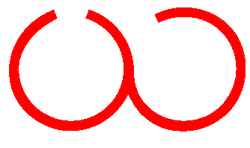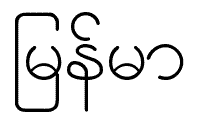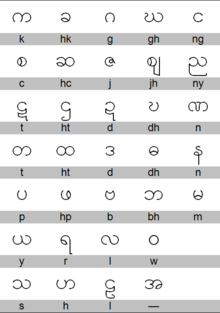Burmese script
| Burmese script | ||
|---|---|---|
| Font | Abugida | |
| languages | Burmese , De'ang , Karen languages , Mon , Shan , Pali | |
| Usage time | since the 11th century | |
| Officially in | Myanmar | |
| ancestry |
Brahmi script → Grantha script → Burmese script |
|
| particularities | Belongs to the Indian font family. | |
| Unicode block | U + 1000-U + 109F U + AA60-U + AA7F |
|
| ISO 15924 | Mymr | |

|
||
The Burmese script ( Burmese မြန်မာ အက္ခရာ " mranma akkha.ra ") is one of the Indian scripts . Like this, it is an intermediate form of the alphabet and syllabary , a so-called Abugida . It is mainly used in Myanmar .
history
Like many other Indian scripts, the Burmese script has its origin in the Brahmi script , which was first used in the 3rd century BC. Is occupied. Over the course of time, numerous regional variants developed from this font, some of which differ greatly.
In the 8th century AD, a descendant of the Brahmi script was introduced in what is now Myanmar in order to write the Mon language . When the Burmese immigrated to the area, they adopted the writing system from the Mon people . The oldest written documents date from the 11th century AD. In the course of time, the original angular script developed into today's round script. The round writing has its origin in the fact that palm leaves were used as a medium at the beginning, which would have been damaged (split) if straight writing symbols had been used.
use
The Burmese script is mainly used to write the Burmese language, which is the official language of Myanmar. Numerous minority languages spoken on Burmese territory use derived forms of the Burmese script, some of which differ significantly. These languages include numerous Karen languages , Shan , Mon, De'ang and other smaller languages. Sanskrit and Pali can also be written with Burmese script .
Working principle
The Burmese script, like the other Indian scripts, is an intermediate form of the alphabet and syllabary, a so-called Abugida. In an Abugida, every consonant that does not have a vowel sign has the inherent vowel “ a. “, Which can be changed by adding vowel signs that are firmly connected to the consonant. The consonant က thus represents a “ ka. " Represents , ကိ on the other hand a" ki. ".
The Burmese script, like the other Indian scripts, is written horizontally from left to right; there is no distinction between uppercase and lowercase letters. Individual words are strung together without a space. Spaces in the text separate parts of sentences. A pause within a sentence is marked with a single vertical line, the end of the sentence with a double vertical line.
Vowel mark
The independent vowel signs on the left are only used for vowels without associated consonants, for example at the beginning of a word or after another vowel. If, on the other hand, a vowel occurs together with a consonant, the combining vowel signs on the right are used, which combine with the consonant sign and form a fixed unit. The combining vowel signs are shown here using the example of the consonant က " k ".
There is no longer any distinction between short and long vowels in Burmese script, the corresponding characters are instead used to mark the tone.
There is a second, alternative form for the vowel mark “ a ”, which, in addition to the vowel of the same name, also occurs as part of the vowel mark “ au ”, which is used with certain consonants such as ဂ “ g ”, e.g. B. ဂါ " ga "; this minimizes mix-ups, as * ဂာ “ ga ” would look exactly like the consonant က “ k ”. Certain languages only use the alternate form.
| Independent vowel signs | COMBINING VOWEL SIGNS | ||||
|---|---|---|---|---|---|
| character | Transliteration | Sound value | character | Transliteration | Sound value |
| အ | a. | [ a̰ ], [ ə ] | က | ka. | [ ka̰ ], [ kə ] |
| အာ | a | [ à ] | ကာ | ka | [ kà ] |
| အား | a: | [ á ] | ကား | ka: | [ ká ] |
| ဣ | i. | [ ḭ ] | ကိ | ki. | [ kḭ ] |
| ဤ | i | [ ì ] | ကီ | ki | [ kì ] |
| အီး | i: | [ í ] | ကီး | ki: | [ kí ] |
| ဥ | u. | [ ṵ ] | ကု | ku. | [ kṵ ] |
| ဦ | u | [ ù ] | ကူ | ku | [ kù ] |
| ဦး | u: | [ ú ] | ကူး | ku: | [ kú ] |
| ဧ့ | e. | [ ḛ ] | ကေ့ | ke. | [ kḛ ] |
| ဧ | e | [ è ] | ကေ | ke | [ kè ] |
| ဧး | e: | [ é ] | ကေး | ke: | [ ké ] |
| အဲ့ | ai. | [ ɛ̰ ] | ကဲ့ | kai. | [ kɛ̰ ] |
| အယ် | ai | [ ɛ̀ ] | ကယ် | kai | [ kɛ̀ ] |
| အဲ | ai: | [ ɛ́ ] | ကဲ | kai: | [ kɛ́ ] |
| အို့ | ui. | [ o̰ ] | ကို့ | kui. | [ ko̰ ] |
| အို | ui | [ ò ] | ကို | kui | [ kò ] |
| အိုး | ui: | [ ó ] | ကိုး | kui: | [ kó ] |
| အော့ | ouch | [ ɔ̰ ] | ကော့ | chew. | [ kɔ̰ ] |
| ဪ | ouch | [ ɔ̀ ] | ကော် | chew | [ kɔ̀ ] |
| ဩ | au: | [ ɔ́ ] | ကော | chew: | [ kɔ́ ] |
Consonants
The Burmese script contains 33 consonants. The sign အ is counted as a consonant, although it is usually part of independent vowel signs. The transliteration is shown in this table without the inherent vowel a, which is usually always present when the consonant does not have a vowel sign or asat.
The consonant ည " ny " has an alternate glyph ဉ . This is used when the consonant comes at the end of a syllable or is combined with the vowel sign " a ".
| character | Transliteration | Sound value |
|---|---|---|
| က | k | [ k ] |
| ခ | hk | [ kʰ ] |
| ဂ | G | [ g ] |
| ဃ | gh | [ g ] |
| င | ng | [ ŋ ] |
| စ | c | [ s ] |
| ဆ | hc | [ sʰ ] |
| ဇ | j | [ z ] |
| ဈ | century | [ z ] |
| ည | ny | [ ɲ ] |
| ဋ | t | [ t ] |
| ဌ | ht | [ tʰ ] |
| ဍ | d | [ d ] |
| ဎ | ie | [ d ] |
| ဏ | n | [ n ] |
| တ | t | [ t ] |
| ထ | ht | [ tʰ ] |
| ဒ | d | [ d ] |
| ဓ | ie | [ d ] |
| န | n | [ n ] |
| ပ | p | [ p ] |
| ဖ | hp | [ pʰ ] |
| ဗ | b | [ b ] |
| ဘ | bra | [ b ] |
| မ | m | [ m ] |
| ယ | y | [ j ] |
| ရ | r | [ j ] , [ r ] |
| လ | l | [ l ] |
| ဝ | w | [ w ] |
| သ | s | [ .theta ] , [ ð ] |
| ဟ | H | [ h ] |
| ဠ | l | [ l ] |
| အ | - | [ ʔ ] |
Ligatures
Under certain circumstances, two consonants within a cluster can be written under each other , similar to the Tibetan script . The consonants keep their original form. For example, in the Burmese word ကမ္ဘာ (“ ka.mbha ”; earth, world) the consonants မ “ m ” and ဘ “ bh ” are written one below the other. The only exceptions are ဿ " ss " and ဠ ္ ဠ " ll ".
If the consonants “ y ”, “ r ”, “ w ” or “ h ” are used as part of a consonant cluster, they form special forms. However, the pronunciation of these special forms is not clear. Several of these forms can appear in one syllable, such as ကျွှ " hkyw ".
| character | Transliteration |
|---|---|
| ကျ | ky |
| ကြ | kr |
| ကွ | kw |
| ကှ | hk |
Digits
The Burmese script has its own numeric characters.
| number | 0 | 1 | 2 | 3 | 4th | 5 | 6th | 7th | 8th | 9 |
|---|---|---|---|---|---|---|---|---|---|---|
| Digit | ၀ | ၁ | ၂ | ၃ | ၄ | ၅ | ၆ | ၇ | ၈ | ၉ |
Romanization
There is no official system for the transcription of Burmese into Latin . The spelling of Burmese terms therefore depends to a large extent on the target language into which they are being transcribed. However, different spellings can be found even on Burmese websites, e.g. B. Tanintharyi - Taninthayi as a name for the Tenasserim division.
Burmese in Unicode
Unicode encodes the Burmese script in the Unicode block Burmese in the code range U + 1000 – U + 109F. Further characters are contained in the Unicode block Burmese, extended-A in the code range U + AA60 – U + AA7F and in Burmese, extended-B in the code range U + A9E0 – U + A9FF.
| 0 | 1 | 2 | 3 | 4th | 5 | 6th | 7th | 8th | 9 | A. | B. | C. | D. | E. | F. | |
|---|---|---|---|---|---|---|---|---|---|---|---|---|---|---|---|---|
| 1000 | က | ခ | ဂ | ဃ | င | စ | ဆ | ဇ | ဈ | ဉ | ည | ဋ | ဌ | ဍ | ဎ | ဏ |
| 1010 | တ | ထ | ဒ | ဓ | န | ပ | ဖ | ဗ | ဘ | မ | ယ | ရ | လ | ဝ | သ | ဟ |
| 1020 | ဠ | အ | ဢ | ဣ | ဤ | ဥ | ဦ | ဧ | ဨ | ဩ | ဪ | ါ | ာ | ိ | ီ | ု |
| 1030 | ူ | ေ | ဲ | ဳ | ဴ | ဵ | ံ | ့ | း | ္ | ် | ျ | ြ | ွ | ှ | ဿ |
| 1040 | ၀ | ၁ | ၂ | ၃ | ၄ | ၅ | ၆ | ၇ | ၈ | ၉ | ၊ | ။ | ၌ | ၍ | ၎ | ၏ |
| 1050 | ၐ | ၑ | ၒ | ၓ | ၔ | ၕ | ၖ | ၗ | ၘ | ၙ | ၚ | ၛ | ၜ | ၝ | ၞ | ၟ |
| 1060 | ၠ | ၡ | ၢ | ၣ | ၤ | ၥ | ၦ | ၧ | ၨ | ၩ | ၪ | ၫ | ၬ | ၭ | ၮ | ၯ |
| 1070 | ၰ | ၱ | ၲ | ၳ | ၴ | ၵ | ၶ | ၷ | ၸ | ၹ | ၺ | ၻ | ၼ | ၽ | ၾ | ၿ |
| 1080 | ႀ | ႁ | ႂ | ႃ | ႄ | ႅ | ႆ | ႇ | ႈ | ႉ | ႊ | ႋ | ႌ | ႍ | ႎ | ႏ |
| 1090 | ႐ | ႑ | ႒ | ႓ | ႔ | ႕ | ႖ | ႗ | ႘ | ႙ | ႚ | ႛ | ႜ | ႝ | ႞ | ႟ |
| A9E0 | ꧠ | ꧡ | ꧢ | ꧣ | ꧤ | ꧥ | ꧦ | ꧧ | ꧨ | ꧩ | ꧪ | ꧫ | ꧬ | ꧭ | ꧮ | ꧯ |
| A9F0 | ꧰ | ꧱ | ꧲ | ꧳ | ꧴ | ꧵ | ꧶ | ꧷ | ꧸ | ꧹ | ꧺ | ꧻ | ꧼ | ꧽ | ꧾ | |
| AA60 | ꩠ | ꩡ | ꩢ | ꩣ | ꩤ | ꩥ | ꩦ | ꩧ | ꩨ | ꩩ | ꩪ | ꩫ | ꩬ | ꩭ | ꩮ | ꩯ |
| AA70 | ꩰ | ꩱ | ꩲ | ꩳ | ꩴ | ꩵ | ꩶ | ꩷ | ꩸ | ꩹ | ꩺ | ꩻ | ꩼ | ꩽ | ꩾ | ꩿ |
- ↑ Code point is not assigned
Individual references and sources
- ↑ a b c Julie D. Allen: The Unicode Standard, version 6.0 . The Unicode Consortium. The Unicode Consortium, Mountain View 2011, ISBN 978-1-936213-01-6 , pp. 354 .
- ^ George L. Campbell: Handbook of scripts and alphabets . Routledge, London 1997, ISBN 0-415-18344-8 , pp. 18 .
- ^ The Unicode Standard, p. 356


